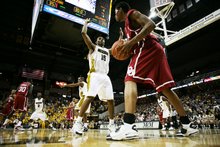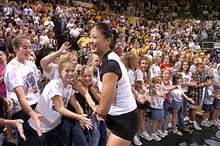So I’ve finally finished entering play-by-play information from 2006...just in time for 2007 to begin. But that’s not going to stop me from looking into numbers to see what I find.
All of the following data is from only Big 12 games, and only from circumstances in which the score of the game is within less than 17 points. What’s the point of gauging what a player or team does when the game’s not in question? Instead of elaborating further, let’s just get started...
First, we’ll look at QB’s. As you’ll see a few posts from now, I will look at “Team Defense” in the same way as I do QB’s. I could do a “Team Offense” number as well, but a) that would be repetitive, and b) the QB is so important that a team’s offense is more greatly affected by his presence (or absense) than any other player’s. In other words, if I’m looking at individual QB’s, I’m not seeing the need to also look at Team Offense.
QB Success Rate
The good people at Football Outsiders (authors of the lovely Football Prospectus books) define a ‘successful play’ or ‘quality play’ by the following criteria:40% of the total needed on 1st down (i.e. if it’s 1st-and-10, 4 yards = success)
QB Success Rate will look at simply the % of plays that were ‘successful’ for each QB, no matter whether the play was a run or pass. This is an attempt to look at the overall efficiency with which a given QB runs his offense. I’m including runs because the effectiveness and efficiency of the running game is directly affected by the effectiveness and efficiency of the QB and his passing game.
70% of the total needed on 2nd down (if it’s 2nd-and-10, 7 yards = success)
100% of the total needed on 3rd or 4th down
Here are the QB Success Rates for 2006 Big 12 Play (for those with at least 10 plays):
1. Colt McCoy, Texas (49.12%, 399 plays)
2. Kerry Meier, Kansas (46.93%, 228 plays)
3. Zac Robinson, Oklahoma State (46.58%, 73 plays)
4. Bobby Reid, Oklahoma State (46.46%, 396 plays)
5. Graham Harrell, Texas Tech (46.21%, 448 plays)
6. Stephen McGee, Texas A&M (46.01%, 589 plays)
7. Chase Daniel, Mizzou (45.74%, 470 plays)
8. Paul Thompson, Oklahoma (45.20%, 542 plays)
9. Todd Reesing, Kansas (42.86%, 42 plays)
10. Jevan Snead, Texas (42.42%, 66 plays)
11. Bret Meyer, Iowa State (40.68%, 381 plays)
12. Zac Taylor, Nebraska (40.41%, 584 plays)
13. Shawn Bell, Baylor (39.93%, 268 plays)
14. Bernard Jackson, Colorado (38.18%, 385 plays)
15. Josh Freeman, Kansas State (37.93%, 406 plays)
16. Blake Szymanski, Baylor (34.58%, 107 plays)
17. Adam Barmann, Kansas (31.03%, 174 plays)
18. Dylan Meier, Kansas State (28.57%, 42 plays)
What a strange list. I mean...STRANGE. A few comments...
• Notice anything interesting about the top of the list? Kerry Meier? Really? Now...a majority of Kansas’ “successful” plays last year were due to Jon Cornish, but...Cornish was the RB when Todd Reesing and Adam Barmann were behind center too, and that didn’t stop their success rates from sucking. I realize Meier was injury-prone and had some very untimely turnovers last year, but...a) he was only a redshirt freshman, and b) he still moved the ball better than the other two. I just can’t see how naming Todd Reesing the starter is anything but counter-productive for the future of Kansas football. I’m not sure Kerry Meier’s anything but a slightly-glorified Kirk Farmer, but he’s still a better option than Reesing, I would think.
• Adam Barmann’s horrid numbers make his explosion against Nebraska that much stranger. Gonna have to go with the "Blind Squirrel and Nut" theory there.
• Yes, that’s Big 12 Offensive Player of the Year Zac Taylor finishing behind Todd Reesing, Jevan Snead, and Bret Meyer. Taylor was good for 1-2 bombs to Purify or others a game (and they obviously still won games), but as a consistent game manager, it appears that Taylor was a bit lacking.
• I think it’s pretty easy to see why Baylor’s QB job was up for grabs once again this offseason.
• I think it’s pretty easy to see why a redshirt freshman (Coach’s Son Hawkins) might be a better option for Colorado.
QB Success Rate by Quarter
Same as above, broken out by quarter. At least 10 plays needed once again. I’ll just do Top 8 by quarter
First Quarter
1. Paul Thompson (56.41%)
2. Jevan Snead (50.00%...on just 12 plays, all against K-State)
3. Chase Daniel (49.07%)
4. Colt McCoy (48.03%)
5. Graham Harell (46.45%)
6. Zac Taylor (45.22%)
7. Bernard Jackson (42.34%)
8. Blake Szymanski (40.91%)
Second Quarter
1. Graham Harrell (60.19%)
2. Kerry Meier (57.65%)
3. Stephen McGee (53.25%)
4. Colt McCoy (52.46%)
5. Bobby Reid (50.00%)
6. Bret Meyer (41.59%)
7. Chase Daniel (41.07%)
8. Zac Taylor (41.06%)
Third Quarter
1. Chase Daniel (52.53%)
2. Colt McCoy (52.22%)
3. Shawn Bell (52.00%)
4. Todd Reesing (50.00%...on just 16 plays)
5. Paul Thompson (48.12%)
6. Bret Meyer (46.46%)
7. Zac Robinson (45.83%)
8. Bobby Reid (43.33%)
Fourth Quarter (I’m listing all of them here, with total plays)
1. Bobby Reid (55.21%, 96 plays)
2. Stephen McGee (50.31%, 159 plays)
3. Zac Robinson (48.39%, 31 plays)
4. Jevan Snead (47.37%, 19 plays, all against K-State)
5. Kerry Meier (45.45%, 22 plays)
6. Todd Reesing (42.11%, 19 plays)
7. Josh Freeman (41.12%, 107 plays)
8. Adam Barmann (40.35%, 57 plays)
9. Colt McCoy (40.00%, 60 plays)
10. Paul Thompson (39.42%, 104 plays)
11. Chase Daniel (38.78%, 98 plays)
12. Zac Taylor (37.31%, 134 plays)
13. Shawn Bell (37.04%, 54 plays)
14. Bernard Jackson (36.67%, 60 plays)
15. Graham Harrell (35.29%, 85 plays)
16. Bret Meyer (34.43%, 61 plays)
Poor Blake Szymanski only had 5 snaps in the 4th quarter when games were within 17 points. This despite playing over half the Big 12 season. Ouch.
Oh, and just so you can compare...
Overall Success Rates by Quarter
First Quarter: 43.33%
Second Quarter: 43.24%
Third Quarter: 43.10%
Fourth Quarter: 41.84%
Now...I’m not totally sure what this says—and I realize we’re dealing with a lot of small sample sizes here—but I’m fascinated.
Comparing their success rate to what’s expected, here are the major QB’s and their rates by quarter...
• Chase Daniel: Q1 = 1.13 (his rate divided by Big 12 rate), Q2 = 0.95, Q3 = 1.22, Q4 = 0.93. Fantastic in the first and third quarters and below average in the second and fourth. Among many other things, this does highlight the strengths and weaknesses of Mizzou’s offensive coaching, something of which we’ve already had our suspicions. They were great in the first quarter, when plays were scripted, and in the third quarter when they were able to make adjustments at halftime. But once the scripts have expired, the play-calling gets a little shakier.
• Meanwhile, Stephen McGee (Q1 = 0.87, Q2 = 1.23, Q3 = 0.91, Q4 = 1.20) was the exact opposite. I thought that might say something about how more physical offensive attacks (like ATM’s) wear opponents down as the half progresses, but Graham Harrell’s strange line (Q1 = 1.07, Q2 = 1.39, Q3 = 0.93, Q4 = 0.84) might prove me wrong. Or does it prove me right? Harrell’s second halves were significantly worse than his first halves. I’m all for the spread offense, but it does show, I guess, that to win with the spread, you better put quite a few points up early because the defense probably won’t wear down against you.
• Paul Thompson’s line (Q1 = 1.30, Q2 = 0.81, Q3 = 1.12, Q4 = 0.94) shows that OU tended to assert itself early, then rely on its defense to pull through. Looking back at certain games (Missouri, Nebraska in the Big 12 title game), that sounds about right.
• For some reason, while McGee thrived in the fourth quarter, the QB’s for the other top teams in the conference (Taylor, McCoy, Thompson) were all below average in the fourth quarter. Part of that is sample size (the QB’s of crappy teams didn’t take nearly as many fourth quarter snaps in close games, so a few good plays could significantly affect their totals), but only part of it. Can’t really explain that.
Here’s the last thing I’m going to look at today...
QB Success Rate in Red Zone
Same as above, only limited by plays taking place inside the opponent’s 25 yard line. I use the 25 instead of the 20 because a) in OT, you get the ball at the 25, and since every play in OT is vita, I’m thinking your odds off scoring had better be just as good from the 22 as it is from the 18.
Conference-wide average was 43.84%.
1. Kerry Meier (60.98%, 41 plays)
2. Bobby Reid (58.06%, 62 plays)
3. Todd Reesing (54.55%, 11 plays)
4. Paul Thompson (53.85%, 91 plays)
5. Bret Meyer (47.22%, 72 plays)
6. Stephen McGee (45.38%, 130 plays)
7. Zac Taylor (44.44%, 90 plays)
8. Zac Robinson (42.86%, 21 plays)
9. Colt McCoy (42.39%, 92 plays)
10. Shawn Bell (41.94%, 62 plays)
11. Chase Daniel (41.24%, 97 plays)
12. Graham Harrell (40.58%, 69 plays)
13. Josh Freeman (32.76%, 58 plays)
14. Adam Barmann (31.03%, 29 plays)
15. Bernard Jackson (23.73%, 59 plays)
A couple interesting things about this...
• First, it does show that the spread offense isn’t amazingly effective in the red zone—Daniel, Harrell, and Bell/Szymanski were all relatively unimpressive.
• However, it doesn’t show that a particular style of offense works better than another. McGee and his ‘cloud of dust’ offense, fared only marginally better than the spread QB’s. KU was great in the red zone (at least with Meier and Reesing at the helm...not so much Barmann), which makes sense because of Jon Cornish. However, why was Cornish effective when other big RB’s (Lane/Goodson at ATM, Brandon Jackson at NU) were just slightly above average? Or in the case of ISU's hoss Ryan Kock, quite below average? (That one can be explained by the fact that Kock only played well against Mizzou...ahem).
Alright, that’s enough for today. I’m going to go position-by-position over the next week or two, pointing out interesting things I find. It stinks that I couldn’t have finished entering the data earlier in the offseason, but...oh well. Better late than never.
Tomorrow: RB’s.
Wednesday, August 29, 2007
Stats Stats Stats: 2006 (QB’s)
Posted by
The Boy
at
12:07 PM
![]()
Labels: Stats Stats Stats
Subscribe to:
Comment Feed (RSS)






|